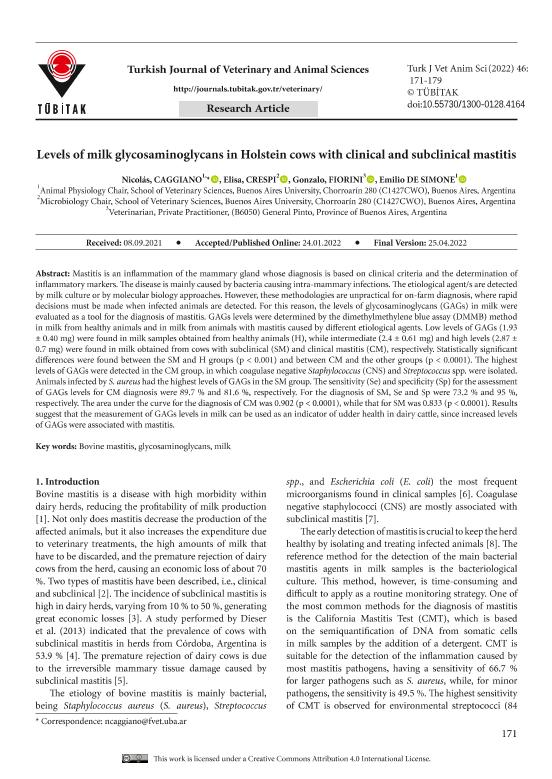Artículo
Levels of milk glycosaminoglycans in Holstein cows with clinical and subclinical mastitis
Fecha de publicación:
03/2022
Editorial:
Scientific Technical Research Council Turkey-tubitak
Revista:
Turkish Journal Of Veterinary And Animal Sciences
ISSN:
1300-0128
Idioma:
Inglés
Tipo de recurso:
Artículo publicado
Clasificación temática:
Resumen
Mastitis is an inflammation of the mammary gland whose diagnosis is based on clinical criteria and the determination of inflammatory markers. The disease is mainly caused by bacteria causing intra-mammary infections. The etiological agent/s are detected by milk culture or by molecular biology approaches. However, these methodologies are unpractical for on-farm diagnosis, where rapid decisions must be made when infected animals are detected. For this reason, the levels of glycosaminoglycans (GAGs) in milk were evaluated as a tool for the diagnosis of mastitis. GAGs levels were determined by the dimethylmethylene blue assay (DMMB) method in milk from healthy animals and in milk from animals with mastitis caused by different etiological agents. Low levels of GAGs (1.93 ± 0.40 mg) were found in milk samples obtained from healthy animals (H), while intermediate (2.4 ± 0.61 mg) and high levels (2.87 ± 0.7 mg) were found in milk obtained from cows with subclinical (SM) and clinical mastitis (CM), respectively. Statistically significant differences were found between the SM and H groups (p < 0.001) and between CM and the other groups (p < 0.0001). The highest levels of GAGs were detected in the CM group, in which coagulase negative Staphylococcus (CNS) and Streptococcus spp. were isolated. Animals infected by S. aureus had the highest levels of GAGs in the SM group. The sensitivity (Se) and specificity (Sp) for the assessment of GAGs levels for CM diagnosis were 89.7 % and 81.6 %, respectively. For the diagnosis of SM, Se and Sp were 73.2 % and 95 %, respectively. The area under the curve for the diagnosis of CM was 0.902 (p < 0.0001), while that for SM was 0.833 (p < 0.0001). Results suggest that the measurement of GAGs levels in milk can be used as an indicator of udder health in dairy cattle, since increased levels of GAGs were associated with mastitis.
Palabras clave:
BOVINE MASTITIS
,
GLYCOSAMINOGLYCANS
,
MILK
Archivos asociados
Licencia
Identificadores
Colecciones
Articulos(OCA PQUE. CENTENARIO)
Articulos de OFICINA DE COORDINACION ADMINISTRATIVA PQUE. CENTENARIO
Articulos de OFICINA DE COORDINACION ADMINISTRATIVA PQUE. CENTENARIO
Citación
Caggiano, Nicolás; Crespi, Elisa Silvia; Fiorini, Gonzalo; de Simone, Emilio Adrian; Levels of milk glycosaminoglycans in Holstein cows with clinical and subclinical mastitis; Scientific Technical Research Council Turkey-tubitak; Turkish Journal Of Veterinary And Animal Sciences; 46; 2; 3-2022; 171-179
Compartir
Altmétricas




